Talaroclauxins A and B: Duclauxin-ergosterol and duclauxin-polyketide hybrid metabolites with complicated skeletons from Talaromyces stipitatus
2024-04-06QinLiMiZhngXiotinZhngLnqinLiMeijiZhengJinbingKngFeiLiuQunZhouXioninLiWeigungSunJunjunLiuChunmeiChenHuhengZhuYonghuiZhng
Qin Li ,Mi Zhng ,Xiotin Zhng ,Lnqin Li ,Meiji Zheng ,Jinbing Kng ,Fei Liu,Qun Zhou,Xionin Li,Weigung Sun,Junjun Liu,Chunmei Chen,∗,Huheng Zhu,∗,Yonghui Zhng,∗
a Hubei Key Laboratory of Natural Medicinal Chemistry and Resource Evaluation,School of Pharmacy,Tongji Medical College,Huazhong University of Science and Technology,Wuhan 430030,China
b Department of In Vitro Diagnostic Reagent,National Institutes for Food and Drug Control,Beijing 100050,China
c State Key Laboratory of Phytochemistry and Plant Resources in West China,Kunming Institute of Botany,Chinese Academy of Sciences,Kunming 650201,China
Keywords: Talaromyces stipitatus (Trichocomaceae) Duclauxin hybrids Single-crystal X-ray diffraction Biosynthetic pathways Neuroprotective effects
ABSTRACT Talaroclauxins A and B (1 and 2),two novel duclauxin hybrids,were obtained from Talaromyces stipitatus,along with three new (3-5) and one known analogue (6).Their structures were determined by NMR spectroscopy,HRESIMS,single-crystal X-ray diffraction,and quantum chemical calculations.Compound 1 is the first example of duclauxin-ergosterol hybrid featuring an unprecedented dodecacyclic ring system formed via a [4+2] cycloaddition,while compound 2,bearing an unusual 6/6/6/5/6/6/6/6 ring system,is a new member of the rare duclauxin-polyketide hybrid class of natural products.Plausible biosynthetic pathways for 1-6 are proposed.Compound 5 displayed moderate neuroprotective effects in glutamate sodium-induced SH-SY5Y cells.
Polyketides play an important role in natural medicinal chemistry due to their complex structures and a wide variety of biological activities such as lovastatin,strobilurin,and fumagillin [1–3].Aromatic polyketides are a large subclass of natural products that have attracted a great deal of attention not only because of their diverse structures and fascinating bioactivities but also their biosynthetic pathways [4–7].Duclauxin derivatives,which are mainly reported fromPenicilliumandTalaromycesspecies,are dimeric oxaphenalenones consisting of at least one unit of the dihydrocoumarin benzo[de]isochromen-1(3H)-one [8,9].The first duclauxin was isolated from the culture of the fungusTalaromyces duclauxiiin 1965 [10],which is a well-known antitumor agent that inhibits ATP synthesis in mitochondria [11].Detailed literature investigation revealed that there are about 36 naturally occurring duclauxins to date,which displayed a diverse range of biological activities,such as cytotoxic,antimicrobial,antiviral,kinase inhibitory,and phytotoxic activities [12].Furthermore,in 2018,Tang and co-workers characterized the cascade of redox transformations in the biosynthetic pathway of duclauxin fromTalaromyces stipitatus[13].The fungusT.stipitatusis a rich source of secondary metabolites,including polyketides,terpenoids,steroids,alkaloids,and so on [14–17],of which duclauxins are the main chemical constituents with 16 examples [12].
In our previous report,four fusicoccane diterpenoids with a 5/8/6 carbon skeleton as well as five steroids were obtained fromT.stipitatus[18,19].During our continuous investigation on this fungus,two novel duclauxin hybrids (1and2) with two types of unique structural frameworks,along with three new (3-5) and a known analogue (6) were isolated (Fig.1).Talaroclauxin A (1)features an unprecedented dodecacyclic ring system that is fused by ergosterol and duclauxinviaa [4+2] cycloaddition.Talaroclauxin B (2) exhibits an unusual 6/6/6/5/6/6/6/6 ring system derived from the polymerization between a duclauxin and an additional polyketide.Herein,we report the isolation,structural elucidation,biological evaluation,and plausible biogenetic pathways of these duclauxin hybrids.
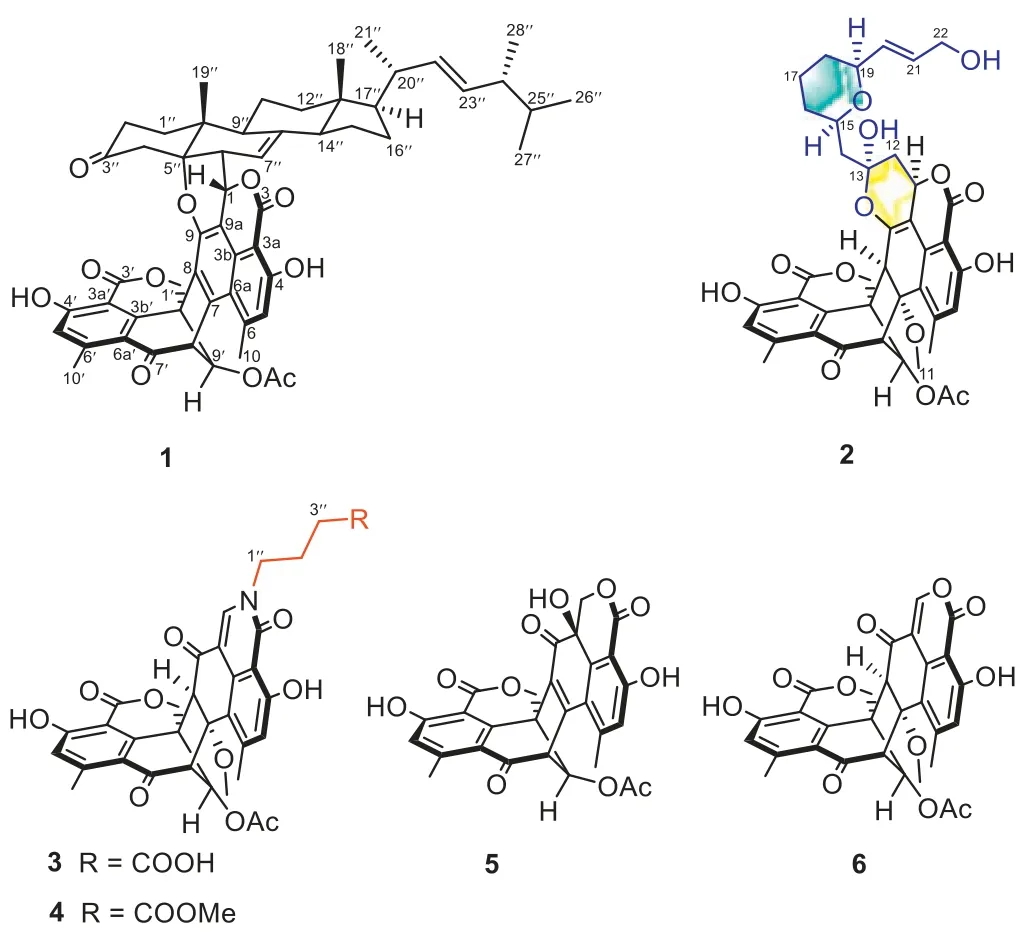
Fig.1.The structures of compounds 1-6.
Talaroclauxin A (1) was obtained as a white powder.Its molecular formula of C56H60O11was determined based on a (+)-HRESIMS peak atm/z931.4038 [M+Na]+(calcd.for C56H60O11Na,931.4033) and required 27 degrees of unsaturation.The1H and13C NMR data (Table S1 in Supporting information) of1displayed characteristic resonances of an ergostane-type steroid [δH5.21 (1H,dd,J=15.3,7.5 Hz),5.13 (1H,dd,J=15.3,8.0 Hz),1.37(3H,s),1.03 (3H,d,J=6.6 Hz),0.89 (3H,d,J=6.8 Hz),0.81(3H,d,J=6.6 Hz),0.79 (3H,d,J=6.6 Hz),and 0.61 (3H,s)].The key1H–1H COSY correlations (Fig.2) of1indicated the presence of four independent spin systems [H2-1′′/H2-2′′,H-6′′/H-7′′,H-9′′/H2-11′′/H2-12′′,and H-14′′/H2-15′′/H2-16′′/H-17′′/H-20′′(Me-21′′)/H-22′′/H-23′′/H-24′′(Me-28′′)/H-25′′/Me-26′′(Me-27′′)].Moreover,the HMBC correlations from Me-18′′ to C-12′′,C-13′′,C-14′′,and C-17′′,from Me-19′′ to C-1′′,C-5′′,C-9′′,and C-10′′,from H2-4′′ to C-2′′,C-3′′,C-5′′,C-6′′,and C-10′′,and from H-7′′ to C-8′′,C-9′′,and C-14′′ constructed the planar structure of the ergosterol moiety.
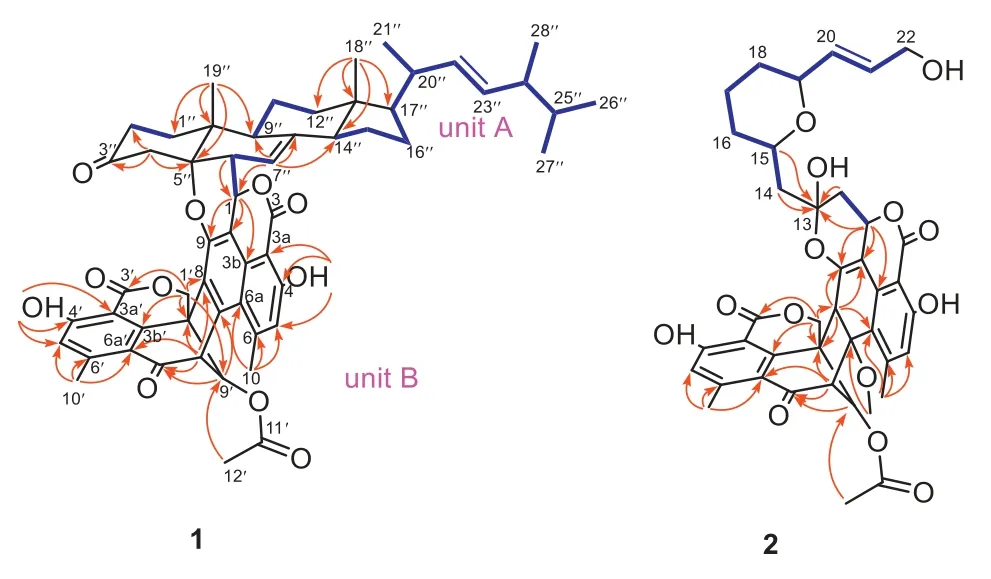
Fig.2.Key 1H-1H COSY,and HMBC correlations of 1 and 2.
The remaining signals were assigned to three methyl singlets(δH3.00,2.59 and 2.02),an oxygenated methylene (δH4.87 and 4.78,both d,J=12.5 Hz),five methines,including two olefinic ones(δH6.94 and 6.86,both s),and 19 nonprotonated carbons,including one ketocarbonyl (δC190.4),three ester carbonyls (δC170.5,170.3,167.2),one sp3quaternary carbon (δC48.4),and 14 olefinic carbons.The NMR-based structural analysis of these remaining signals indicated a condensed polyaromatic system which was challenging due to the low H/C ratio.Based on literature investigations,the aforementioned NMR data indicated that the unit should be a duclauxin.The main HMBC correlations from Me-10(10′) to C-5(5′),C-6(6′) and C-6a(6a′),from H-1(1′) to C-3b(3b′),C-9(9′) and C-9a(9a′),from OH-4(4′) to C-3a(3a′),C-4(4′) and C-5(5′),from H-5(5′) to C-3a(3a′),C-4(4′),C-6(6′) and C-6a(6a′),from H-8′ to C-7,C-7′ and C-9a′ confirmed the planimetric map of unit B which was similar to bacillisporin A [20].The connectivity of the two units through the C-1-C-6′′ and C-9-O-C-5′′,which was deduced by the1H-1H COSY correlation of H-1/H-6′′ and the remaining one degree of unsaturation,as well as the highly deshielded13C chemical shift of C-5′′ (δC88.3) compared with (22E,24R)-ergosta-7,9(11),22-trien-3β,5β,6β-triol (δC74.2) [21].
The relative configuration of the core steroidal part was assumed to be the same as that of typical ergosterol analogues and confirmed by the corresponding NOESY correlations (Fig.S1 in Supporting information) of H3-19′′/H3-18′′,H3-19′′/H-6′′,H-9′′/H-14′′,H-14′′/H-17′′,H3-18′′/H3-21′′,and H-20′′/H-16′′.The key NOESY correlation of H-1 and H-4′′ unraveled the orientation of H-1.As almost no coupling was observed between H-8′ and H-9′,suggesting a torsion angle ofca.90° between these two protons.In addition,NOESY correlations of H-8′/H-9′,H-8′/H3-10 as well as H-9′/H-1′αare in agreement with the configuration of bacillisporin A [20].Furthermore,the key NOESY correlations of H-1′ and H-9′′ established the whole relative configuration of compound1.To further confirm the relative configuration of1,the theoretical13C NMR calculation of1(1S∗,1′S∗,8′R∗,9′S∗,5′′S∗,6′′S∗,9′′R∗,10′′R∗,13′′R∗,14′′R∗,17′′R∗,21′′R∗,24′′R∗)was performed,and the calculated13C NMR of1matched well with experimental data (Fig.S2 in Supporting information).Finally,the absolute configuration of1was determined as 1S,1′S,8′R,9′S,5′′S,6′′S,9′′R,10′′R,13′′R,14′′R,17′′R,21′′R,24′′Rby ECD calculations (Fig.3).
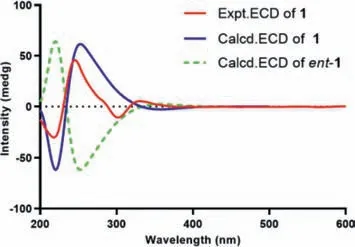
Fig.3.Comparison of the experimental and calculated ECD spectra of 1.
Talaroclauxin B (2)was isolated as a colorless crystal and gave a molecular formula of C40H40O14based on its HRESIMS ion peak atm/z767.2313 [M+Na]+(calcd.for C40H40O14Na,767.2316),indicating 21 degrees of unsaturation.The1H and13C NMR data(Table S2 in Supporting information) of2showed similarity to those of1,and the difference was the appearance of an additional nine-carbon alkyl chain and absence of ergosterol signals in2,which was supported by the1H-1H COSY correlations (Fig.2)of H2-14/H-15/H2-16/H2-17/H2-18/H-19/H-20/H-21/H2-22.Furthermore,the HMBC correlations from H2-14 and H-15 to C-13 suggested that the alkyl chain was located at C-13.Finally,based on the chemical shifts of C-15 (δH4.32;δC74.8) and C-19 (δH4.11;δC77.4) along with the degrees of unsaturation,a pyran ring was assignedviaan oxygen bridge between C-15 and C-19.
The NOESY correlations of H-8′/H-9′,H-8′/H3-10,H-9′/H-1′α,H-8/H-1′β,and H-8/H3-11 suggested identical configurations in the duclauxin moiety [8].Moreover,the strong NOESY correlation between H-15 and H-19 indicated they were cofacial.However,it is a challenge to uncover the whole relative configuration of2by interpreting the NMR data alone.With a varied range of attempts,a single crystal of2suitable for X-ray diffraction was obtained by slowly crystallizing in MeOH/CH2Cl2(1:1) at room temperature,which confirmed both planar structure and absolute configuration of2(Fig.4).
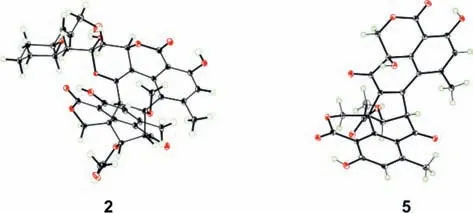
Fig.4.X-ray structures of 2 and 5.
Talaroclauxin C (3) gave an ion [M+Na]+atm/z654.1573,consisting with the molecular formula of C33H29NO12and indicating 20 degrees of unsaturation.Detailed analyses of 1D and 2D NMR data showed that compound3is similar to bacillisporin H [16],except for the presence of a butanoic acid chain,which was disclosed by the1H-1H COSY correlations (Fig.S5 in Supporting information) of H2-1′′/H2-2′′/H2-3′′ and the HMBC correlations from H2-2′′ and H2-3′′ to C-4′′.Additionally,the HMBC correlation from H-1 to C-1′′ supported that the chain was located at the N atom.Talaroclauxin D (4)was isolated as a faint yellow powder and gave an HRESIMS ion peak corresponding to a molecular formula of C34H31NO12,which was 14 mass units more than3.The only difference was that the carboxyl group in3was replaced by a methoxycarbonyl in4,which was confirmed by the presence of an additional methoxyl (δH3.73,s;δC52.0) and the HMBC correlation from Me-5′′ to C-4′′.The NOESY correlations of H-8′/H-9′,H-8′/H3-10,H-9′/H-1′α,H-8/H-1′β,and H-8/H3-11 were similar to those of2,suggesting the same relative configuration for3and4.The absolute configurations of3and4were established as 7S,8S,8′S,9′S,9a′Rbased on their experimental ECD spectra (Fig.5) showing almost the same Cotton effects as these of duclauxin [22].
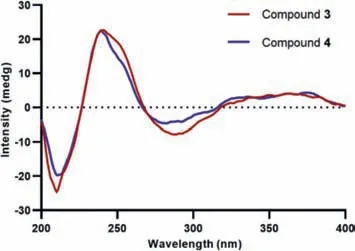
Fig.5.Experimental ECD spectra of compounds 3 and 4.
Talaroclauxin E (5)was isolated as a colorless crystal with the molecular formula of C28H20O11(19 degrees of unsaturation),as deduced from the molecular peak atm/z555.0913 [M+Na]+in the HRESIMS.Interpretation of the1H and13C NMR data (Tables S3 and S4 in Supporting information) revealed that5possessed the same planar structure as bacillisporin E [20],except for the slight differences in H2-1 (δH4.89 and 4.42 in5;δH4.90 and 4.82 in bacillisporin E),indicating that5is likely the C-9a epimer of bacillisporin E.Finally,a high-quality crystal of5was obtained from a solution of MeOH at 4 °C,which confirmed the above analyses based on the flack parameter of 0.024(5) (Fig.4).
The possible biosynthetic pathways of1-6are proposed as shown in Scheme 1 and Scheme S1 (Supporting information).Firstly,the diradical-coupling of two oxaphenalenone monomers produced a heptacyclic oligophenalenone dimer,which could be converted to compounds5and6.On the one hand,after a dehydration reaction of5,intermediateIwith an additional double bondΔ1,9awas generated.Then,theα,β-unsaturated ketone inIand the olefinic functionality at C-5 and C-6 in the (22E)-ergosta-5,7,22-trien-3-one could undergo a [4+2] cycloaddition reaction to obtain1.On the other hand,compound2could be producedviatwo possible pathways (A and B) from6.In pathway A,the [4+2]cycloaddition reaction of6andb(enoic acid) was the key step,which was followed by a decarboxylation.In pathway B,a Michael addition reaction was proposed as the key step between compound6anda(the keto form ofb) led to the key intermediateIII,and the followed decarboxylation and intramolecular nucleophilic addition reactions led to compound2.In addition,6might undergo acylation with a glutamic acid,followed by the nucleophilic addition to form intermediateV,which was then transformed into3by decarboxylation and into4by an additional methylation (Scheme S1).
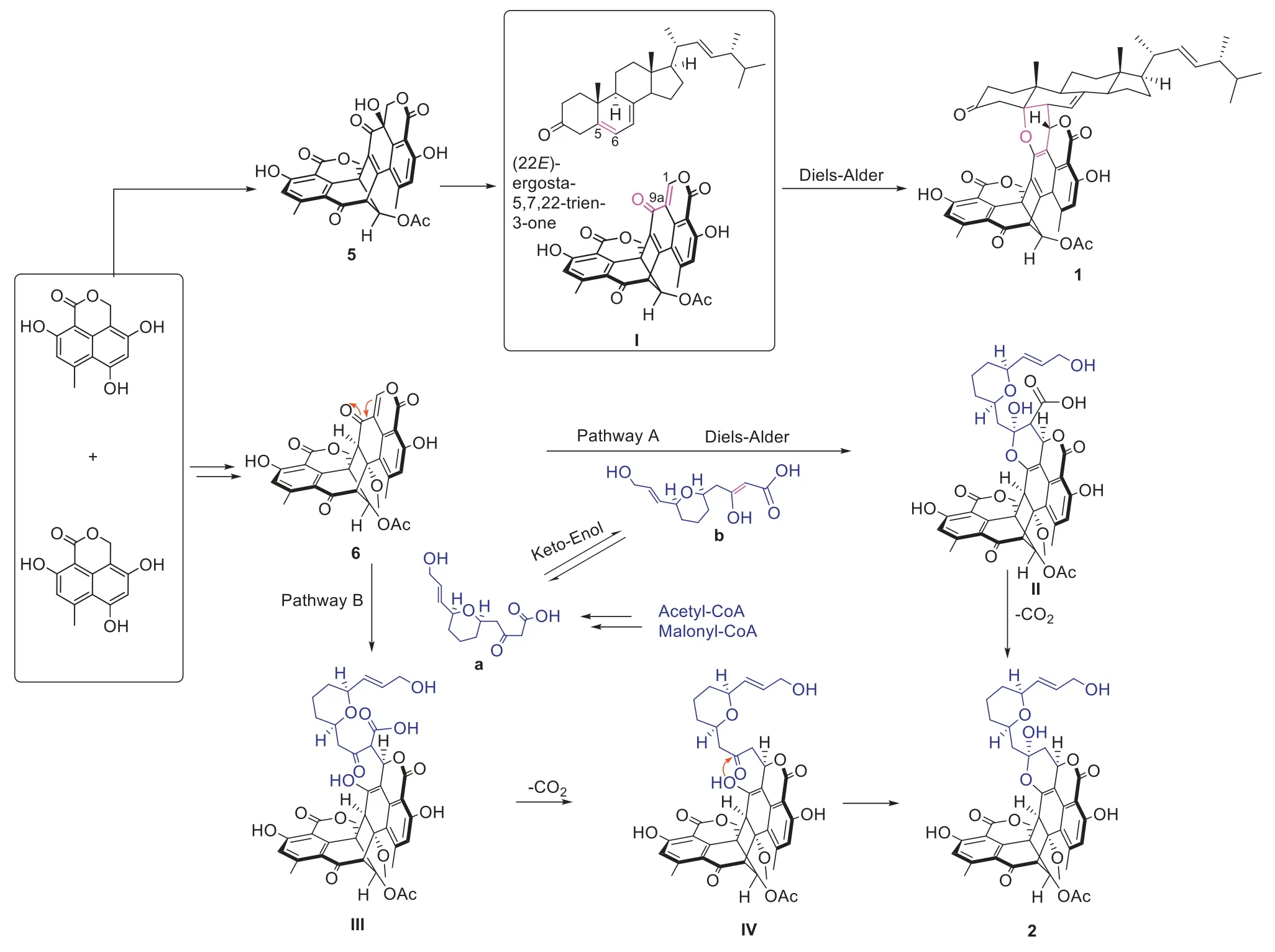
Scheme 1.Hypothetical biosynthetic pathways of compounds 1 and 2.
After no-toxicity confirmation (Fig.6A),the cytoprotective and anti-neuroinflammatory activities of1-6were evaluated.Encouragingly,compound5showed potential neuroprotection effect against 20 mmol/L glutamate-induced oxidative injury in SH-SY5Y cells,which was better than the H2O2oxidative stress model(Figs.6B and C).Treated with 5 and 10 μmol/L of5could significantly reduce the glutamate-induced cell death from 39.6% to 15.2% and 9.5%,respectively.The additional Annexin V-FITC/PI double dying assay showed that5can reduce the large proportion of apoptotic cells in a dose-depended manner which was consistent with the CCK8 assay (Figs.6D and E).Furthermore,the lower ROS production verified that5dose-dependently resisted the oxidative stress (Figs.6F and G).These results suggested that5inhibited ROS production in SH-SY5Y cells and thereby inhibited glutamateinduced oxidative injury.In addition,5simultaneously showed significant protective effects on LPS-induced BV-2 cell injury and attenuate NO production,combining the decreasing transcriptional levels of several inflammatory associated genes,including AMPK,TNF-α,PPARα,IL-18,and TLR4 (Fig.S8 in Supporting information).All results demonstrate5may be a potential candidate for regulating oxidative injury and neuroinflammatory response in the brain for nervous system disease.
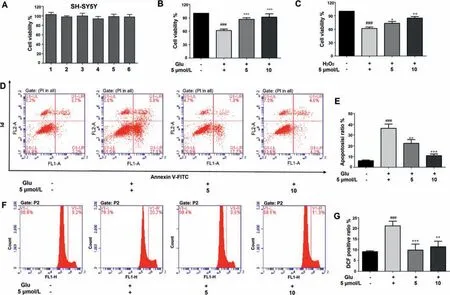
Fig.6.The cytoprotective activity of 5 against glutamate/H2O2-induced oxidative injury in SH-SY5Y cells.(A) Cytotoxicity assay of 1-6 in SH-SY5Y cells.(B,C) The cytoprotective activity of 5 in glutamate (20 mmol/L) or H2O2 (500 μmol/L) induced cell injury.(D,E) Flow cytometry was applied to determine the apoptotic ratio after Annexin V-FITC/PI staining.(F,G) The intracellular ROS production was measured using DCFH-DA method.All results were calculated as the mean ± SD.###P < 0.001 vs.the control group;∗P < 0.05,∗∗P < 0.01 and ∗∗∗P < 0.001 vs.the glutamate or H2O2-treated group.
In conclusion,two novel duclauxin hybrids together with three new and one known analogues were isolated fromTalaromyces stipitatus.Compound1represents the first example of duclauxin-ergosterol hybrid possessing an unprecedented 6/6/6/5/6/6/6/6/6/6/6/5-fused dodecacyclic scaffold,and compound2is a new member of the rare duclauxin-polyketide hybrid.Moreover,compound5exhibited neuroprotective effects in SH-SY5Y cells,indicating that5might be a promising leading scaffold for regulating oxidative injury and neuroinflammatory response in the brain for nervous system disease.
Declaration of competing interest
The authors declare that they have no known competing financial interests or personal relationships that could have appeared to influence the work reported in this paper.
Acknowledgments
This work was financially supported by the Program for Changjiang Scholars of Ministry of Education of the People’s Republic of China (No.T2016088),the National Natural Science Foundation for Distinguished Young Scholars (No.81725021),the National Natural Science Foundation for Excellent Young Scholars (No.81922065),Innovative Research Groups of the National Natural Science Foundation of China (No.81721005),the National Natural Science Foundation of China (No.82173706),the Science and Technology Major Project of Hubei Province (No.2021ACA012),the Research and Development Program of Hubei Province (No.2020BCA058),the Academic Frontier Youth Team of HUST (No.2017QYTD19),and the Integrated Innovative Team for Major Human Diseases Program of Tongji Medical College (HUST).The authors thank the Analytical and Testing Center at the Huazhong University of Science and Technology for assistance in the acquisition of the NMR,ECD,and UV spectra.The computation is completed in the HPC Platform of Huazhong University of Science and Technology.
Supplementary materials
Supplementary material associated with this article can be found,in the online version,at doi:10.1016/j.cclet.2023.108193.
杂志排行
Chinese Chemical Letters的其它文章
- Spin switching in corrole radical complex
- Benzothiadiazole-based materials for organic solar cells
- Mono-functionalized pillar[n]arenes: Syntheses,host–guest properties and applications✰
- Recent advances in two-step energy transfer light-harvesting systems driven by non-covalent self-assembly✩
- From oxygenated monomers to well-defined low-carbon polymers
- Doping-induced charge transfer in conductive polymers
